![]()
Types of Audio Cables/Adapters
Cables are an important part of the recording process. Without the right connections, nothing can be recorded. What follows is a summary of the most common types of cables and adapters that can be used in the recording process when recording from a computer to a minidisc. The cables/adapters listed on this page are as follows:
 Analog miniplug Analog miniplug |
TOSLINK-to-miniplug |
 RCA cable RCA cable |
Coaxial-to-miniplug |
 Miniplug-to-RCA cable Miniplug-to-RCA cable |
USB analog |
 Digital coaxial cable Digital coaxial cable |
USB digital |
 TOSLINK TOSLINK |
Digital coaxial/optical conversion |
| .Analog miniplug | ... | |||||||
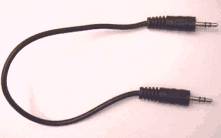
|
A miniplug cable is a cable which has a 1/8-inch miniplug at both ends. It is the most common kind
of cable for computer recording. Any computer with a soundcard can be recorded
from (and to) using this type of cable.
A miniplug-to-miniplug cable is only capable of carrying analog signals. There are different qualities of this cable available; some have a silver tip and others have a gold tip which is supposed to help the connections to be better. In practice however, you probably won't hear much difference in the sound quality between the various qualities of this type of cable that are available. The good news is that this type of cable is available at virtually any electronics or stereo shop; it is always easy to obtain one of these cables, for only a few dollars, from Radio Shack in North America. Note that when buying this type of cable, be careful to buy a stereo cable, NOT a "mono" one. How to tell? The stereo cables have two black rings around the plug. The illustration to the left shows the two black rings that indicate that this is a stereo cable. Mono cables of this type have only one black ring. Mono cables will not produce good results: they may only record in one "ear", leaving the other one blank. |
|||||||
| . | ||||||||
| .RCA Cable | ||||||||
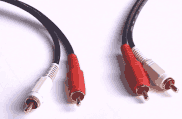 |
First developed by the Radio Corporation of America in the 1970's the RCA cable has been the standard in home audio recording for over 30 years. The cable has 2 connectors (known as "RCA connectors") at each end, making a total of four connectors. One is for the "left" channel, and one is for the "right" channel. This cable is used for analog recording. Most portable devices (such as portable Minidisc recorders) do not have RCA connectors, since these connectors take up too much space. Instead, portables use 1/8-inch jacks which use miniplug cables. However, all component recording devices (such as component recording minidisc recorders) have RCA jacks and would use RCA cable. On the other hand, most computer soundcards do not have RCA jacks; again because they take up too much space. There are, however, some exceptions. One is certainly the SoundBlaster Live! Drive daughter board, which has RCA jacks on its front panel. | |||||||
| . | ||||||||
| .Miniplug-to-RCA cable | ||||||||
 |
This cable has one 1/8-inch miniplug at one end, and 2 RCA plugs at the other. It is an analog cable. It is used when one device has an 1/8-inch jack and the other device has RCA jacks. A typical application for this cable would be a case where a soundcard has a 1/8-inch jack but a minidisc deck has only RCA inputs. Therefore, to record audio from the computer, the 1/8-inch plug will be plugged into the computer's 1/8-inch "speaker out" or "line out" connection, while on the other end the RCA plugs will be plugged into the minidisc deck's "line in" jack. | |||||||
| . | ||||||||
| .Digital coaxial cable | ||||||||
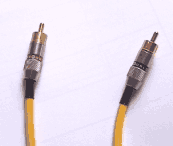 |
This cable, as its name implies, used for digital recording. It looks very much like analog RCA cable, except that there is one RCA connector instead of two. This cable is sometimes referred to as an SP/DIF cable; which can be misleading because "SP/DIF" can actually refer to many types of cables which happen to follow the SP/DIF (Sony Philips Digital Interface) standard. This one connector is used to send and receive a signal that is meant for both the "left" and "right" channels. The digital coaxial cable is the most preferred choice for digital connections, considered to be the most reliable and of good quality (for home recording). There are no portable minidisc recorders which have a coaxial connection; however many of the more expensive minidisc component decks have a coaxial "in" and "out". The cable itself must be rated at 75 ohms to carry the digital signal; usually any RCA cable that is good enough to carry a video signal (from a VCR to a TV, for example) will also be adequate for carrying a digital signal. | |||||||
| . | ||||||||
| .TOSLINK | ||||||||
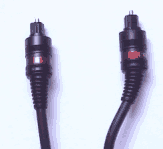 |
"TOSLINK" means "Toshiba-Link", named after the cable's inventor, Toshiba. This is a digital cable, used almost exclusively by consumer-grade component equipment. TOSLINK cables are digital cables, representing the "0"'s and "1"'s in the digital code by light instead of electrical signals. Thus this type of cable is often referred to as an "optical" cable. This cable is a type of "SP/DIF" cable. Some soundcards have TOSLINK jacks; other soundcards require the addition of a daughter card to add this capability. If both the computer and the midisc destination (deck) have TOSLINK jacks, then the TOSLINK cable is plugged into the "out" on the computer and the "in" on the minidisc deck. | |||||||
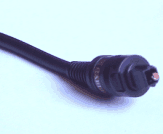 |
This is a view of the end of a TOSLINK cable when it is plugged into a piece of equipment which sends out an optical digital signal. Note how the tip of the cable glows red in color. This is actually a very bright red when you see it yourself. What you are seeing is the actual light used to transmit the digital code over the cable. Inside the cable is a piece of fibre-optic "wire" over which the light travels. | |||||||
| . | ||||||||
| .TOSLINK-to-miniplug | ||||||||
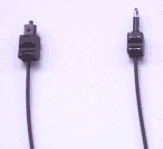 |
This is the most common type of cable used for digital recording to minidisc portables. This cable has a TOSLINK plug on one end, and a miniplug on the other. It is a type of "optical" cable, and uses light to represent the digital information instead of electricity. It is also another type of "SP/DIF" cable. The miniplug that is on one end looks to be the same size as an analog 1/8-inch miniplug, but again, it has an important difference: It carries light, not electricity. Therefore although it appears to be the same as a 1/8-inch analog cable, in fact it is quite different. Most portable minidisc recorders are equipped with a "line in" jack which can accept both analog AND digital miniplugs. The electronic circuitry inside the recorder itself will "sense" whether the signal being sent through the cable is the electric analog one, or the optical digital one. In a typical situation recording from a computer to a minidisc, the TOSLINK end of this cable is plugged onto the "out" on the computer, and the 1/8-inch miniplug is plugged into the "line in" of the portable minidisc recorder. | |||||||
| . | ||||||||
| .Coaxial-to-miniplug | ||||||||
 |
This is a digital cable used to send electrical digital information. It has one RCA connector at one end and one 1/8-inch miniplug at the other. It is yet another type of SP/DIF cable. This type of cable can be used with portable digital gear; however to my knowledge there are no minidisc recorders that use this type of cable. It is used by portable DCC and DAT equipment. In the case of recording audio from a computer, the RCA plug is plugged into the digital coaxial "out" jack on the computer, while the 1/8-inch miniplug is plugged into the portable DCC or DAT. | |||||||
| . | ||||||||
| .USB Analog | ||||||||
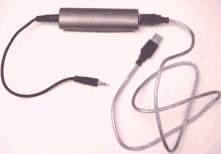 |
This is not so much a "cable" but an "adapter"; however for the purposes of this page it is appropriate to discuss it here. A USB cable was developed by a company called Xitel to allow transfer of audio from a computer to a minidisc recorder via the USB port and thereby bypassing the soundcard altogether. This is appropriate if the soundcard present is not very good, if there is no soundcard at all, or if the user simply wants the simplicity of the user-friendly minidisc software that comes bundled with the USB connector. In the analog version, the audio data is converted to an analog signal by an inline converter and sent to the minidisc recorder via a 1/8-inch miniplug. | |||||||
| . | ||||||||
| .USB Digital | ||||||||
 |
The USB digital, like its analog cousin, is not actually a cable but an adapter. The digital version plugs into the USB port on a computer and sends a digital signal to the minidisc recorder. The signal sent is an SP/DIF optical signal. | |||||||
| . | ||||||||
| .Digital coaxial to optical conversion | ||||||||
 |
This is an adapter that will convert a digital coaxial signal to a digital optical one. Owners of soundcards which have digital coaxial (but no optical) outputs could benefit from using one of these format converters. There are several manufacturers of format converters; however some of these format converters can be more expensive than upgrading the soundcard. However, depending on your setup this may be a viable option for you. There are many manufacturers of format converters, producing format converters at a various price ranges. The links below list only a sampling of the format converters available:
|
|||||||
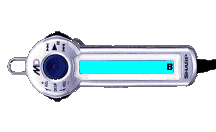 |
 |